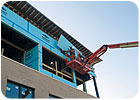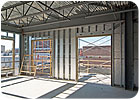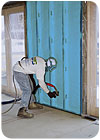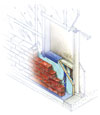

The city of Birmingham is roughly 20 miles northwest of downtown Detroit and is one of several developing areas in Southeast Michigan. As the city grows with commercial and institutional business, developers that reside there are looking closer at sustainable building practices. Like other metropolis areas, the city got a whiff of the loft boom and will surely capitalize on it.
What marks this project as unique is that it is the first job in North America that will feature Dow’s new Total Wall System. This system, for commercial steel stud wall assemblies, is designed to achieve high energy efficiency, qualify for LEED certification and will contribute to large energy savings. The system offers continuous insulation value, air-barrier protection and a flashing system all-in-one. Dow says the system, which incorporates its Thermax exterior sheathing, Stryofoam spray polyurethane foam and Weathermate flashings, offers contractors ease of design and installation. This advantage reduces construction time needed to install the system, the bonus of less cost and labor.

“In watching many of the larger construction projects going on in metro Detroit, like the casinos, we felt there was a better way to simplify the details that the architects had come up with. Not only was it costly, it was subcontractor specific so there was no multi-tasking among subcontractors and it didn’t provide you with any quick construction methods,” says Steve Marszalek, principal with Mosher, Dolan, Cataldo & Kelly. “We found out later also had structural implications because it pushed the plane of your building out farther than you wanted it to. So you had to increase your structural field back to the building and it became a real vicious circle of trying to work through all those details.”

The company had a meeting to discuss alternatives and it was suggested that the company contact Dow since Mosher, Dolan, Cataldo & Kelly was going to use its cavity-mate product on the project anyway. The call was placed to see if Dow could provide a system that was a more simple system or “a way that we could draw the envelope of the building back to where it belonged,” Marszalek says.
Dow representatives had informed Mosher, Dolan, Cataldo & Kelly of a new product that it offered that solved these concerns. Both companies spent three months working through those details in refining the product, the Total Wall System (not to be confused with the company of the same name).
The three-in-one package system benefits the contractors in many ways. For one, it enables an energy-efficient, moisture-managed wall with less materials and installation steps. Drywall contractor Dun-Rite worked on the project and used this system. Its owner, Bruce Schihi, says the Total Wall System provides a “better” exterior shell package with improved vapor and moisture seal. “The dew point is moved to the exterior finish of the wall area, virtually eliminating condensation behind the brick line.” He says the outcome is less labor and material costs.
Typically, gypsum based wall systems begin with two men hanging board into place, then installation of the foam, a basecoat of waterproofing membrane and then a finish coat.
“When it’s done, you’re up to four trips around the building’s exterior,” says Dun-Rite’s carpentry/drywall foreman Jerry Vanderpool. “Not only is Thermax quicker to install, it’s really easy to use. I can cut it with a drywall saw-and few cuts are needed since the 12-foot Thermax boards are longer than gypsum boards, at 8 feet max. I can use fewer fasteners compared to exterior gypsum-three screws per stud vs. about seven with gypsum. And one guy can handle it easily … since it is so lightweight …”

“It is a system because it’s done in conjunction with metal studs, insulation and spray foam insulation on the interior for air migration,” says Marszalek. “If you have the right carpenter, they can do all the functions: install the studs, sheath the walls, install the brick ties and if certified also spray foam the studs. So you have a total wall construction all done by one contractor. From a construction manager’s standpoint … I now have the ability to line up the next set of subcontractors to get immediately started. Now I have a building that is safe, cost efficient to heat and it’s secure. And those are values that you can’t even put a price on in the construction standpoint.”
This project also introduced contractors to the concept of blowing spray foam insulation from the inside. Dow’s Styrofoam spray polyurethane foam, part of the Total Wall System, was applied on the interior of the steel studs. In theory, this will stop air infiltration by filling the gaps and penetrations, and supply strong moisture management and elimination of air convection in the wall. Jointly, the foam serves as insulation to the wall unit.
When asked what the cost for the system was compared to buying each of the products piecemeal, Marszalek says it came out roughly the same to a conventional gypsum-based system. The cost of turning a building over sooner along with the energy costs to heat was substantial.
The project broke ground in April 2007 and is slated for completion by this fall. When complete, the building will achieve USGBC LEED certification and a Gold rating.
“I hope the product catches on,” says Marszalek. “It’s a product that makes everybody’s lives easier-architects, builders, carpenters, etc.” W&C



Report Abusive Comment